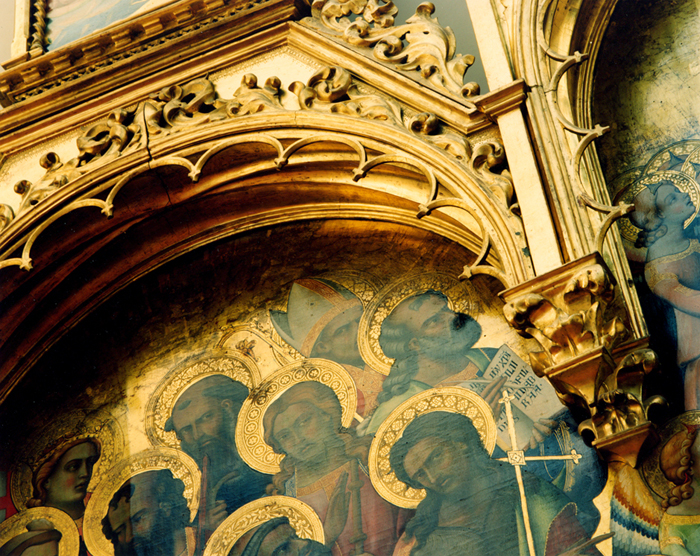
Origin: Room 5-6 – International Gothic
Detail: Lorenzo Monaco , Coronation of the Virgin , 1414
Galleria degli Uffizi
Alongside this angle-of-view, the image size, grain structure, method of display, and, most significantly, the exposure times of each photograph are integral to the exhibition's construction. The large size (39 x 47 in) and color saturation allow the finest details of each photographed subject, the irregularities of each brushstroke, chisel trail, embroidered stitch, and stain to be uncompromisingly and clearly seen. They express Walter Benjamin's concept of the optical unconscious:
the enlargement of a snapshot does not simply render more precise what in any case was visible, though unclear: it reveals entirely new structural formations of the subject…
Evidently a different nature opens itself to the camera than opens to the naked eye – if only because an unconsciously penetrated space is substituted for a space consciously explored by man. 1
Impossible Gaze revels in this photographic trait. The ability to freeze time and produce a static image enables an uninhibited, slow examination. The photographs arrest the otherwise elusive details of an ephemeral experience, suspending a fragment and enlarging it for a new viewer to explore the intricate details that could not have been absorbed during the original encounter.
The exposure times for each of the images in Impossible Gaze are excessively long, as demanded by the low, ambient lighting of the museum. In this work, five or six minutes are required to render the detail to film. This slowness deliberately disrupts the desire for “photographic instantaneity” as it refuses the speed encouraged by technology. 2 The extended time that passes in front of my lens's open shutter signifies the time required to actually “see” the contextual details of these museum environments.
These photographs, in essence, reproduce an “impossible gaze” not only because of each long exposure, but also by virtue of the ever-flowing tide of museum visitors obstructing the viewer's field of vision and making concentration for any duration practically impossible. Constantly confronted by battalions of tour groups jostling through the historic architecture, there is little choice but to shuffle along with fellow cultural devotees, peering over a sea of heads in search of universal icons. The pace of expeditious cultural pilgrimages, set by the flag-bearing tour guides, is militant. This ever-increasing tendency to move quickly through museums is endemic. Thoroughly conditioned to the flickering of images and messages across screens and billboards, viewing regimes have become fractured, superficial and diversely juxtaposed in an attempt to digest the vast quantity of visual information that inhabits our world.
Mediated by the milling crowds, the viewer's gaze is rarely focused on one thing, as it is constantly interrupted by activity. The museum experience is a social spectacle, swarming with people engaged in the activity of viewing, albeit in varying degrees. It is paradoxically both a collective encounter and a solitary one, one of curiosity, confusion, and contemplation that simultaneously elicits a sense of lightness, rejuvenation, exhaustion, and loss.
1. Walter Benjamin, “The Work of Art in the Age of Mechanical Reproduction,” in Illuminations , Hannah Arendt, ed., Harry Zohn trans. (New York: Schoken Books, 1969), 236.
2. Paul Virilio, Vision Machine (London: B. F. I. Pub, 1994), 2.